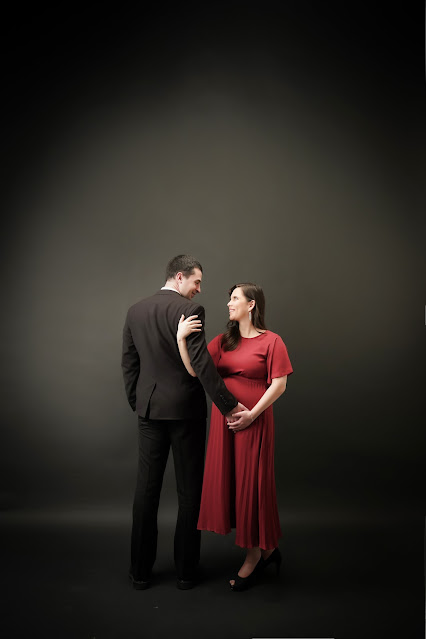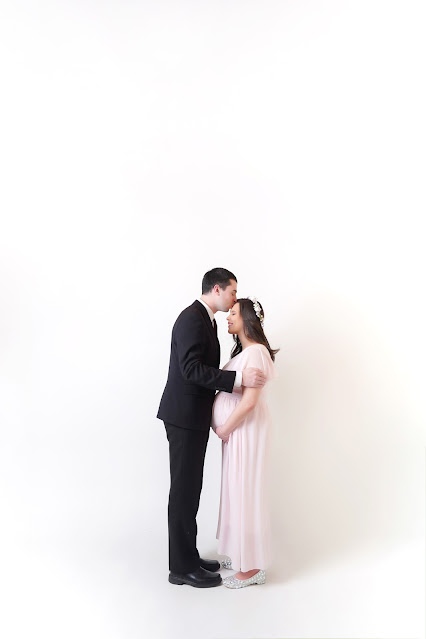
It's so funny that I spent this whole pregnancy saying I didn't want to take maternity photos. I even refused to take weekly progress photos like M wanted because I just knew I'd forget a week or two and it would drive me nuts that the whole record would be incomplete. (Plus, I was supposed to be trying to do less this year overall.)

But I kept getting calls and texts from a photo studio affiliated with the postnatal luxury spa (산후조리원) where we'll be staying after the birth, and with each marketing pitch I felt myself warming up more and more to the idea. What really sealed the deal was confirming that it was "free" to get the photos taken, and we could see if we liked them before deciding to buy any. My thought was: well, if they're that confident we're going to love them, they must be good! (Yes, I realize that's how they get you. What can I say? They got me.)

So M and I grabbed a taxi one Saturday afternoon to Birthday Studio, which was located in Gangnam. I had applied a base coat of makeup before I left home and grabbed a flower crown I'd ordered online and a few sets of earrings in case I needed multiple options. Once we arrived, I was whisked to hair and makeup (all included, along with dress and shoe rental) while M relaxed in a waiting room. I could choose up to two dresses, but I brought my own in case their sizes didn't fit me or didn't meet my religious standards of modesty. In the end, I chose one of their dresses (a delicate pink that matched the flower crown I brought) and wore my own, a burgundy dress.

I imagine the staff spoke some English, but I communicated with them in Korean and they seemed much more comfortable. Once I was dolled up, I met up with Marwan in a studio room where a photographer with the most English ability of anyone we met there directed us into hundreds of poses. I love it when a photographer knows exactly what they want and tells you just what to do. I never know exactly how to stand or what to do with my arms or feet to get the absolute best photo, but the studio photographer had it down even to pinky finger placement.

The space for taking photos was small but comfortable, with various lighting options and a plain chair we used for some of the photos. I liked the simplicity of it and how we weren't asked to use a bunch of cheesy props as I've heard some studios do. The same kind lady who did my hair and makeup was also on standby to help with any flyaways and hair mishaps, which is especially helpful if you have mischievous bangs like me.

After we finished our photo shoot, we were escorted to the waiting room, brought some water and juice, and told to wait a bit while they prepared the photos. I assumed that meant they were picking the best ones to present to us as part of their sales pitch at the end. Little did I know they were assembling a whole promotional video complete with quotes perfectly designed to pull on any pregnant person's heartstrings!

When another staff member walked in with the prepared files, M and I sat patiently while she pulled them up on the screen. Imagine my shock and surprise as they played a video they had secretly recorded of M while I was doing hair and makeup, telling me how much he loved me and what a great mother I would be! I admit, I was already teary in the first few minutes. Then they hit me with the full blast of maternity photo highlights, affirmations, and poetic quotes. Yup, at that point I was a goner. And we hadn't even talked prices yet!

One of the nice things about getting maternity photos at a Korean studio is that they tend to do photo packages. A typical "full" package includes maternity photos, newborn photos, 50-day photos (for 50 days after the birth), and 100-day photos (you get the idea). We decided to spring for maternity photos, newborn photos, and 50-day photos but to hold off on any more since we knew we'd be moving back home soon and family would probably want to do pictures, together, too.

The prices were very reasonable and much less than what we'd expect to pay in the United States (at least in the DC area). We got the package of those three photo occasions (again, including hair and makeup and dress and shoe rental) including digital files, photo editing for our favorites, and a small album for 600,000 Korean won (about $500). They also said if we changed our mind we could always add the 100-day photos to our package later.

I'm so happy with how these first photos turned out and look forward to treasuring those newborn and 50-day photos, too! Photographers and photo studio staff are amazing people, using their creative talents to capture the special moments in people's lives. I'm so grateful Birthday Studio kept calling and texting me, or I might never have decided to take the plunge and get these photos.






